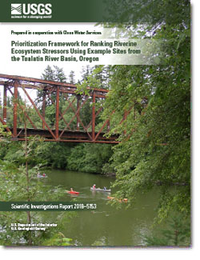Prioritization Framework for Ranking Riverine Ecosystem Stressors Using Example Sites from the Tualatin River Basin, Oregon
Links
- Document: Report (3.7 MB pdf)
- Download citation as: RIS | Dublin Core
Abstract
As human populations increase, so does their influence over the environment. Altered terrain, degraded water quality, and threatened or endangered species are all-too-common consequences of a growing anthropogenic influence on the landscape. To help manage these effects, researchers have developed new ways to characterize current environmental conditions and help resource managers seek solutions to bring affected areas back to their best attainable health. Before an ecosystem can be improved, however, its current level of ecological stress must be determined. Characterizing environmental conditions at many sites across a landscape helps managers understand the range of current conditions and prioritize where they might focus restoration and protection efforts.
This report details the development of a prioritization framework to score riverine ecosystem stressors in a watershed based on example sites from the Tualatin River Basin in northwestern Oregon. The framework incorporated the most influential site-specific stressors throughout the basin built on a long history of data collection. These stressors were characterized with 13 metrics that were organized into 4 groups: hydrologic, water quality, physical habitat, and biological. Each stressor metric used readily accessible data and was translated to a score between 0 and 10. The higher the score, the healthier the site. This initial application of the framework used field observations and measurements to rank site conditions at two Tualatin River sites and four Tualatin River tributary sites. Given the versatility of this framework, it easily could be expanded to include more sites or new metrics, if necessary. Because stressors varied by season, all metrics for the tributary sites were scored separately during the wet season (November through April) and dry season (May through October). Water-quality data were available over a prolonged period; therefore, water-quality metrics were assessed by season and by decade (1990–99 compared to 2000–12) to evaluate long-term stressor trends.
Results for the Tualatin River Basin prioritization framework indicated that the urban tributaries demonstrated the greatest stress throughout the year, especially during the dry summer months. Spatially, the upper Tualatin River was healthier than the lower reaches of the river. Water-quality has improved in the last 10 years, mostly due to improvements in the dry period contaminant scores, but challenges remain with high water temperatures and low dissolved-oxygen conditions.
The biggest challenge with this type of research derived from inconsistencies within the available data. Both spatial and temporal data gaps must be addressed to improve the prioritization. Incorporating both discrete and continuous datasets into the prioritization framework remains a challenge because the datasets have slightly different information and criteria and are not always comparable. Regardless, this report provides guidelines for developing a prioritization framework that ranks the ecological health of sites in a watershed and provides guidance on management actions for improving conditions by targeting factors that greatly affect the health of river ecosystems.
Suggested Citation
Sobieszczyk, S., Jones, K.L., Rounds, S.A., Nilsen, E.B., and Morace, J.L., 2018, Prioritization framework for ranking riverine ecosystem stressors using example sites from the Tualatin River Basin, Oregon: U.S. Geological Survey Scientific Investigations Report 2018-5153, 40 p., https://doi.org/10.3133/sir20185153.
ISSN: 2328-0328 (online)
Study Area
Table of Contents
- Abstract
- Introduction
- Controls, Processes, and Stressors That Shape Riverine Ecosystems
- Selecting Stressors, Metrics, and Scoring Translators
- Tualatin River Basin Scoring Examples
- Application of Prioritization Framework
- Summary
- Acknowledgements
- References Cited
- Appendix 1. Prioritization Framework Ranking and Raw Scores
| Publication type | Report |
|---|---|
| Publication Subtype | USGS Numbered Series |
| Title | Prioritization framework for ranking riverine ecosystem stressors using example sites from the Tualatin River Basin, Oregon |
| Series title | Scientific Investigations Report |
| Series number | 2018-5153 |
| DOI | 10.3133/sir20185153 |
| Publication Date | December 03, 2018 |
| Year Published | 2018 |
| Language | English |
| Publisher | U.S. Geological Survey |
| Publisher location | Reston, VA |
| Contributing office(s) | Oregon Water Science Center |
| Description | vii, 40 p. |
| Country | United States |
| State | Oregon |
| Other Geospatial | Tualatin River Basin |
| Online Only (Y/N) | Y |


